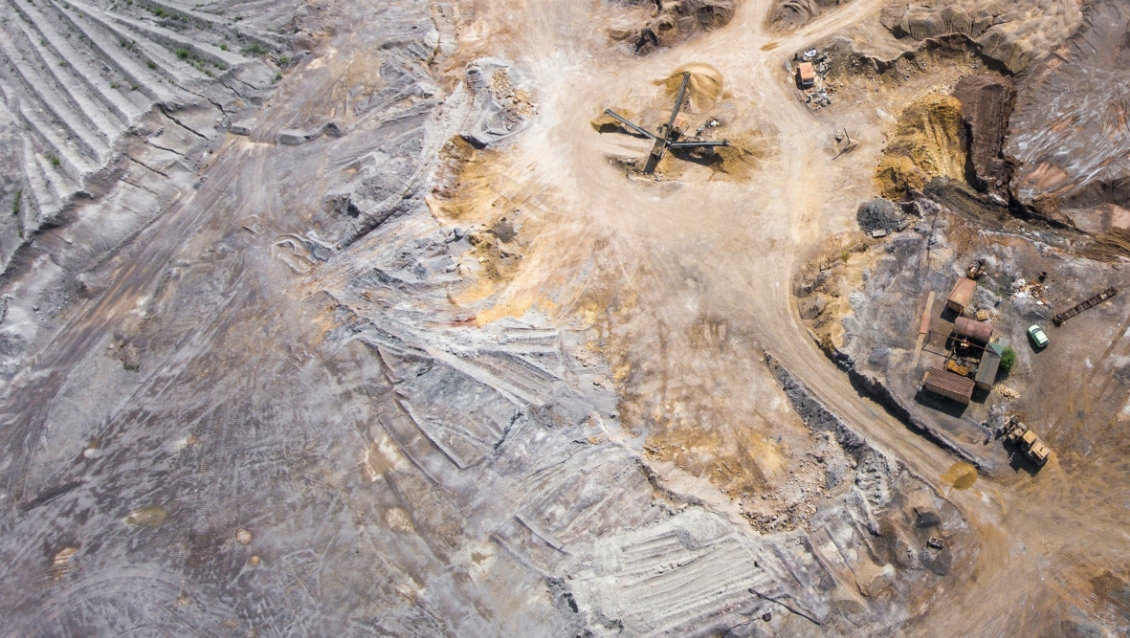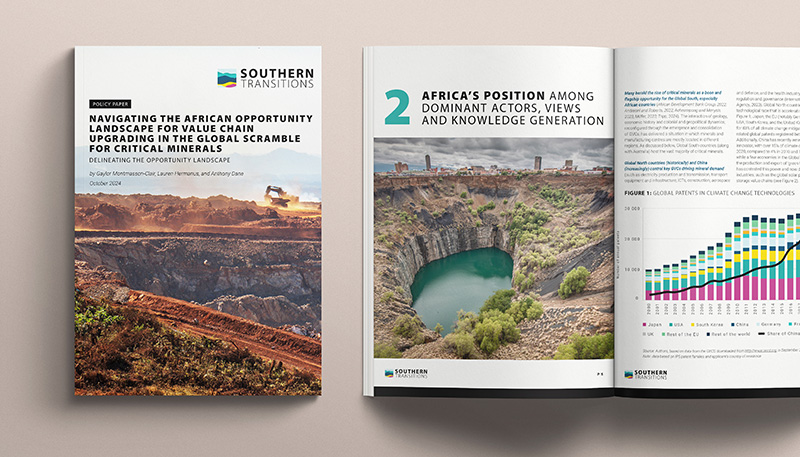Navigating the African Opportunity Landscape for Critical Minerals: A Q&A Discussion with Gaylor Montmasson-Clair of Southern Transitions

Posted on 19 June 2025
A policy paper published by Southern Transitions urges African governments to craft context-specific, self-determined strategies for critical minerals by building local knowledge, strengthening regional cooperation and reducing reliance on external expertise.
Executive Summary
- A 2024 policy paper by Southern Transitions calls on African governments to define and own their strategy for critical minerals by understanding their specific opportunities, constraints and positions in global value chains.
- The report highlights that the majority of African countries lack detailed, context-specific mineral development plans integrated into broader socio-economic visions.
- Strengthening research in Africa, regional cooperation and institutional capacity is vital to countering narratives shaped by the Global North.
- Above all, Africa must generate its own knowledge, build its negotiating position and reduce its dependence on external expertise to articulate its development path.
In 2024, Southern Transitions published a policy paper entitled ‘Navigating the African Opportunity Landscape for Value Chain Upgrading in the Global Scramble for Critical Minerals’ co-authored by Gaylor Montmasson-Clair, Lauren Hermanus, and Anthony Dane. The policy paper focuses on the question of critical minerals development across Africa. It does this by outlining and contextualising Africa’s current position in the current opportunity landscape as part of the global scramble for critical minerals.
Navigating the African Opportunity Landscape for the Value Chain Upgrading in the Global Scramble for Critical Minerals (Report)
The questions that follow reflect on the key policy implications and interrogations that arise from the findings of the report. They are intended to support a wider policy conversation about how best African countries can leverage their mineral endowments for sustainable economic development. The questions were posed to Gaylor Montmasson-Clair, Director and Co-Founder of Southern Transitions – one of the co-authors of the report. This report, alongside many other policy resources such as mineral profiles, news and strategies, can be found on the African Green Minerals Observatory website.
With regards to critical minerals, the report argues that Africa needs to better formulate its “ask.” Can you explain why efforts to define Africa’s critical minerals opportunity have been unclear to date, and how this research hopes to make a contribution to correct this lack of clarity?
Indeed, it is fundamental that African governments recognise and exercise their agency on mineral resource markets. Doing so requires that each country understands and unpacks, in detail, its strengths and weaknesses, mineral by mineral. Most African countries do not have a dedicated mineral development strategy. Those that exist are often high-level and generic. Importantly, mineral development strategies are also rarely integrated into a broader socio-economic vision, plan and framework.
Without a clear picture of what African countries aim to achieve – and can realistically hope to deliver in the short term – through the development of their mineral value chains, value chain upgrading and value capture strategies are unlikely to materialise, be sustainable, or support the country’s development goals.
Our report is in essence a call to action for African stakeholders – governments, businesses, civil society and researchers – to do their homework. It is only by fleshing out our ‘ask’ that we can ensure that a) the relevant and necessary interventions are taken on the domestic front, and b) the right deals are struck at the market (state-to-company) and international (state-to-state) levels.
The report highlights how research centres in the Global North often shape the narratives and generate the evidence base on the issue of critical minerals. How can mineral-rich countries in the Global South better work and cooperate to articulate their interests with regards to critical minerals?
The development of critical minerals is an area of intensive negotiations and dealmaking by both producing and consuming countries, driven by large-scale (mostly foreign) investment. In this global scramble for rent and resources, it is striking to see that most research and intelligence on African critical minerals originates from countries in the Global North, and China. They often know more about African markets and opportunities than we do. And African often institutions regularly rely on this skewed body of work for their own analysis – a problematic situation.
We need to back ourselves because no one else will. And given most African countries’ financial and human resource challenges and the opportunity to coordinate to increase market power and agency, it makes sense to do so regionally and continentally. That means supporting African multilateral institutions, such as the African Union’s African Minerals Development Centre (AMDC), the African Union Development Agency (AUDA-NEPAD) and the African Development Bank. Moreover, regional bodies, such as regional economic communities and the Organisation of African Geological Surveys but also think tanks and research centres – like the South African Institute of International Affairs and Southern Transitions – also require long-term support.
While the critical minerals opportunity is often framed as a continental one for Africa, your report argues that only a handful of African countries are globally relevant. What do you think is the implication of this finding with regards to continental, regional, and national strategy making on critical minerals?
This is a fundamental finding. Indeed, the African mineral landscape is generally considered generically, looping all countries into one homogenous group. Thinking of the opportunity landscape uniformly undermines the development of context-specific pathways, acknowledging the strengths and weaknesses of each country and each value chain. Effectively, it assumes that all African countries have the same mineral resource endowment and the same position in global value chains. This is highly problematic.
The reality is that few African countries are in a globally dominant situation. And this position is mineral specific. South Africa (manganese, platinum group metals), the Democratic Republic of Congo (cobalt), Guinea (bauxite) and Morocco (phosphate rock) are the only African economies with leading market power in critical mineral value chains. What they can negotiate and achieve through their mineral value chains is vastly different from other countries who are in more marginal positions. It also impacts how they can do so (i.e. the levers that they can pull to increase value capture). That being said, it is important to note that this heterogeneity does not mean that small producing countries cannot leverage their mineral endowments. It just calls for differentiated strategies.
Recognising the diversity of contexts also opens the door to craft meaningful African partnerships, which can be structured around geographical proximity or value chain integration. Approaching the debate in this way helps us ask constructive questions about critical mineral policymaking. For example, how can all African countries involved in the aluminium value chain – cutting across bauxite mining in Guinea, alumina refining in Ghana, aluminium smelting in Mozambique and downstream manufacturing in South Africa, among others – work together to build regional value chains or at least increase their competitiveness and market power?
The report stresses the fact that the African opportunity landscape for critical minerals differs from country to country and is context specific. Can you unpack some of the factors that have a bearing on this context?
Context indeed matters. As raised earlier, each country faces different conditions. As such, the opportunity landscape varies significantly from one country to another. Opportunities to ‘catch up’ by leveraging critical minerals are therefore ultimately context specific.
A set of factors has an important bearing on this context:
- First, the demand profile of a given mineral has a significant impact on investments and the overall market.
- Second, the role of a country within existing production structures matters. A dominant producer (or exporter) has much more control over market dynamics and is in a stronger position to negotiate conditionalities than a marginal one.
- Third, the state of productive capabilities within an economy largely dictates the set of possible near-term opportunities. While a lack of existing capabilities (and linkages) does not prevent catching up and upgrading strategies and pathways, their presence can enable a much more rapid structural transformation.
- Linked to this, the level of dependency on the prevailing structure of mineral extraction plays a role. Again, without being deterministic in nature, a highly undiversified economy with a high degree of dependency on mineral extraction will face deeper challenges than a country with multiple, existing competitive economic activities.
- Lastly, the prevailing political settlement (in other words, the political economy) in a country, especially the alignment of (or ability to align) both public- and private-sector interests to drive a transformative, developmental agenda, has a significant influence on the probability of success.
In sum, every country has opportunities, but these are not necessarily the same as their neighbour. Understanding the local and global context for critical minerals is a foundational prerequisite to truly grasp the opportunity landscape, thereby dramatically increasing the likelihood of policy success.
If there is one key insight you learnt from conducting the research that you would like for policymakers to pay attention to, what is this insight and why do you believe it is important?
At the risk of sounding like a broken record, it all starts with doing our homework!
Because every piece of research is skewed in some way, we cannot rely solely on external analysis and expertise to craft our own understanding and strategic direction. Others have long internalised this reality. They are doing their homework, both on their own situation and on us. It is time that we did the same.
